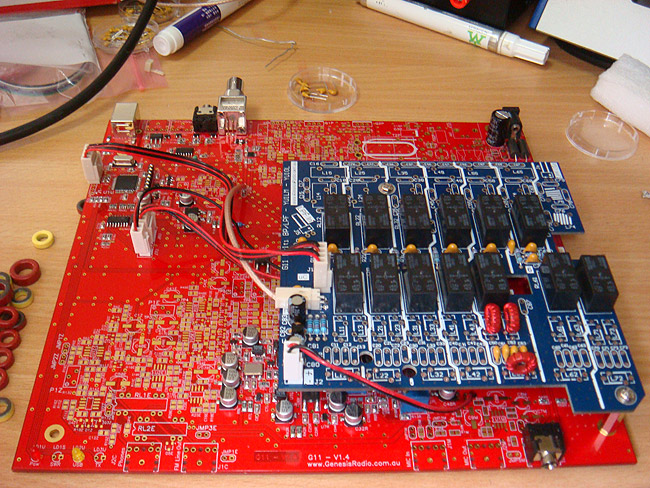No programming knowledge is required - as long as you follow the instructions outlined in this chapter.
To get the job done, you need the following:
1. PICKit2 or a similar programmer suitable for 18F4550 Microchip micro controller
2. a cable to connect PICKit2 and G11 board
3. the hex file
PICKit2 [or PICKit3 as well as number of clones] is available on eBay for around $20-$30 postage included. My preference is old and reliable PICKit2 but this unit is no longer in production so it is a bit hard to find. Again, any unit will do the job as long as it is suitable for G11 uc which is 18F4550.
The connecting cable is something you need to make yourself. One end of the cable will have a 7 pin header to match J5U on G11 board. On the other end it will have a 5 pin header to match the PICKit output connector. Only 5 pins will be interconnected so you need a length of 5 wire ribbon cable. Keep it reasonably short.
Wire as per photo. The white triangle on the PicKit is alignmnt mark for pin 1. Pin 6 is not connected.
Wiring order on the J5U side:
Pin 1 on the top is not connected, pins 2 and 3 are joined together, and the others are as per the photo.
The hex file itself was mailed to you at the time you've placed an order for G11 bare board. You may have overlooked that, so go and check your inbox. If you haven't got it, or can't find it, email me again with your callsign and paypal receipt.
Assuming that you have previously installed PICkit on your PC, you are now ready to go!
1. make sure that the G11 board is not connected to power.
2. connect the PICKit and G11 with the cable you've just made, then connect the programmer via USB cable to your PC.
3. run it!
4. if your uc is installed correctly, it will be recognized by programmer with 'device' showing PIC18F4550.
5. enable VDD by ticking the box next to ON. The 5.0V should be pre-set automatically.
6. try the connection by clicking on Blank Check. If the connection is working fine, you will see the message 'Device is Blank'.
If device is not blank, click on Erase then Blank Check again.
7. Go to "file" then "Import HEX file". Locate G11boot.hex, then Open.
8. Programmer screen will display "Hex file successfully imported" and you can see part of the code.
9. Click "Write". After few seconds you will see "Programming Successful" message.
10. The USB led on G11 board will be lit.
At this point you have successfully loaded G11 boot file.
NOTE: clicking on 'Verify' will result in error message. The verification process is not possible due to code lock. Ignore this warning.
You are now ready to proceed to the next phase of assembly: installation of USB components.
NOTE: if you are using other programmer than PICKit 2 or PICKit 3, here is the schematic diagram which explains how to connect the programmer.
Link to diagram.




































